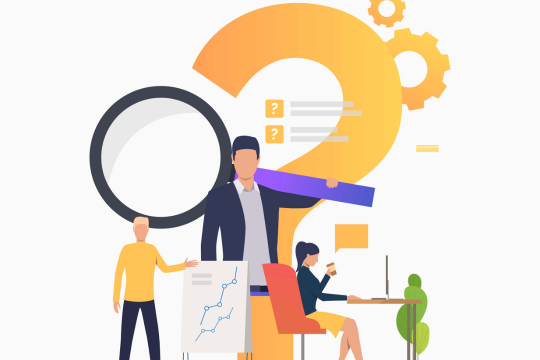What are Discovery Services ?
In the era of digital innovation, startups and incumbent businesses alike are always seeking new ways to develop impactful products, minimize risk, and deliver to user expectations. The Discovery Phase is one of the building blocks in that pursuit when critical decisions are made that affect the life cycle of the product. The tools and processes employed in this phase are what are known as discovery services.
Discovery Servicesfacilitates teams in developing an intimate knowledge of their users, market context, and the issue they are addressing. The services make sure that your product team does not venture further into development without understanding but instead begins with clarity, confidence, and a user-centric attitude. These services are necessary to align strategy with execution, reduce waste, and develop digital products that address real-world issues in the best possible manner.
Let's find out about the six critical components of Discovery Services:
1. Discovery Workshops
What it is:
Discovery workshops are jointly held sessions between stakeholders, product managers, designers, developers, and possibly users. These workshops aim at getting everyone on the same page regarding the vision, goals, issues, and expectations surrounding the product.
Purpose:
- To determine the scope of the project and goals.
- To recognize possible roadblocks ahead of time.
- To have shared understanding and alignment among the entire group.
Activities involved:
- Brainstorming sessions
- Competitor analysis
- Ideation and sketching
- Prioritization of features or problems
Why it matters:
Workshops set the stage for effective communication. They create a collaborative atmosphere and get everyone on the same page. Teams that bypass this step usually encounter misalignment, conflicting priorities, and vague objectives, which can result in expensive changes in mid-development cycles.
Moreover, these meetings are an excellent platform to experiment with new concepts, validate assumptions, and identify opportunities that might not be surfaced by documentation. Discovery workshops are usually led by product strategists or UX leaders who ensure the results are actionable and business-aligned.

2. User Interviews
What it is:
User interviews are guided discussions with prospective or current users to learn about their needs, behavior, pain areas, and expectations. This qualitative technique gives first-hand information regarding how users think and behave.
Purpose:
- To obtain genuine user feedback before creating a product.
- To uncover unspoken needs and pain points.
- To test assumptions using real information.
Techniques:
- One-to-one interviews (physical or remote)
- Open-ended questioning
- Empathy mapping
Why it matters:
User interviews reveal the human side of product development. Instead of building based on guesswork, you’re designing for real people with real problems. This research reduces the risk of building a product that doesn’t meet user expectations.
These learnings also feed into persona development, user journey mapping, and feature prioritization. Teams can miss critical user insight or build on assumptions if they do not have interviews. These discussions must be free of bias and open-ended so users feel comfortable sharing their honest thoughts and opinions.
3. MVP Prioritization
What it is:
Minimum Viable Product (MVP) prioritization is the act of determining the features that are necessary to ship the initial version of your product. It makes you concentrate on essential functionalities that address the primary user issue.
Purpose:
- To reduce the risk and cost of development.
- To establish product-market fit as early as possible.
- To receive user feedback on the most critical features.
Well-known frameworks:
- MoSCoW (Must have, Should have, Could have, Won’t have)
- Kano Model
- Value vs. Complexity matrix
Why it matters:
By targeting "must-haves" for your MVP, you are not over-releasing or spending too much. It enables you to iterate and test your idea rapidly based on actual feedback.
MVP prioritization also assists in planning timelines and resources. Most companies fail in attempting to create a product with all the features before launch. This is what an MVP prevents you from doing. An MVP teaches you what users need and want. Launching quickly and learning sooner keeps you agile and competitive within the marketplace.
4. Audits
What it is:
Audits are the process of reviewing current digital products, platforms, or internal systems to identify inefficiencies, usability problems, or technical debt. Audits are typically broken down into UX audits, SEO audits, and technical audits.
Purpose:
- To gauge the state of your digital assets today.
- To highlight quick wins and key issues.
- To ensure your product is up to industry best practices.
Types of audits:
- UX Audit: Identifies usability problems, accessibility issues, and design inconsistencies.
- SEO Audit: Analyzes how your website ranks in search engines and identifies areas for improvement.
- Technical Audit: Evaluates code quality, scalability, performance, and integration issues.
Why it matters:
Before launching something new, it’s important to know what’s already working and what’s not. Audits help prevent repeating past mistakes and establish a solid foundation for future development.
A good audit gives a roadmap for improvement, prioritizing what to fix based on its impact. For instance, a technical audit can uncover that the platform isn't scalable for expansion in the future, and a UX audit can demonstrate that users are having difficulty performing important tasks. These findings are essential to provide a great experience and prevent rework down the line.

5. Market Research
What it is:
Market research entails collecting and analyzing information regarding your target market, industry patterns, competitor plans, and customer profiles. It is both a quantitative and qualitative exercise.
Purpose:
- To learn about the competitive environment.
- To recognize trends and opportunities.
- To confirm the need for your product.
Methods employed:
- Surveys and questionnaires
- Industry documents
- Competitive benchmarking
Why is it important?
Building a great product isn’t just about features—it’s also about timing, relevance, and market positioning. Market research helps ensure you’re not solving a problem that nobody has.
It also guides pricing strategies, marketing campaigns, and feature development. Understanding user demographics and behaviors can help tailor your value proposition and differentiate your product in a crowded market. Ignoring market research can lead to product failure even if the technology is excellent.
6. User Journey Mapping
What it is:
User journey mapping is a visual representation of the experience of a user with a product or service. It identifies the actions taken by a user, their feeling at every step, and the friction points, if any, they face.
Purpose:
- To be empathetic towards users at every step.
- To spot pain points and opportunities.
- To provide a seamless user experience from end to end.
Parts of a user journey map:
- Persona (Who is the user?)
- Scenario (What are they trying to do?)
- Touchpoints (Where do they touch base?)
- Emotions (How do they feel?)
Why it matters:
User journey mapping will guarantee that your product design is user-focused. It will enable you to create experiences that are intuitive, engaging, and valuable.
By imagining the journey, you can grasp moments of joy and frustration more easily. Refining features, minimizing friction, and maximizing conversion rate are all made easier. A good journey map can inform design and development decisions and align the team in delivering best-in-class user experiences.
Final Thoughts
Discovery servicesaren't merely a front-end exercise—they're a potent tool to create improved products. By taking the time to learn about users, establish goals, review existing solutions, and research the market, companies can greatly improve their odds of success.
Whether you're building a new startup or refreshing an existing platform, the Discovery Phase guarantees you build with intent, with clarity, and with direction. Don't omit it—welcome it. A well-discovered product means a well-delivered product.
Integrating discovery servicesinto your digital product roadmap not only reduces risks, but it alsoamplifies opportunity. It synchronizes business objectives with user requirements and makes your product stand out in a crowded market. From initial idea tests to market fit and technical evaluation, Discovery Servicesis the driving force behind successful product growth.
